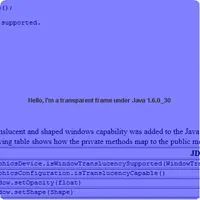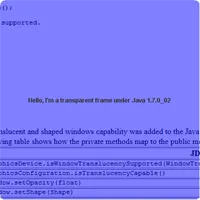我正在尝试创建一个圆形窗口,该窗口跟随鼠标移动并将点击事件传递到底层窗口。
我之前用Python和Qt来实现(参见Python overlay window),但是后来我改用Java和Swing。然而,我无法使窗口透明。我尝试了此方法,但它并不起作用,但我认为我的系统支持透明度,因为如果我启动Screencast-O-Matic(这是一个使用Java编写的程序),矩形实际上是透明的。
我应该如何实现类似的效果?(我在Linux KDE4上)
我正在尝试创建一个圆形窗口,该窗口跟随鼠标移动并将点击事件传递到底层窗口。
我之前用Python和Qt来实现(参见Python overlay window),但是后来我改用Java和Swing。然而,我无法使窗口透明。我尝试了此方法,但它并不起作用,但我认为我的系统支持透明度,因为如果我启动Screencast-O-Matic(这是一个使用Java编写的程序),矩形实际上是透明的。
我应该如何实现类似的效果?(我在Linux KDE4上)
import java.awt.*; //Graphics2D, LinearGradientPaint, Point, Window, Window.Type;
import javax.swing.JComponent;
import javax.swing.JFrame;
import javax.swing.SwingUtilities;
/**
* From JavaMagazine May/June 2012
* @author josh
*/
public class ShapedAboutWindowDemo {
/**
* @param args the command line arguments
*/
public static void main(String[] args) {
//switch to the right thread
SwingUtilities.invokeLater(new Runnable() {
@Override
public void run() {
JFrame frame = new JFrame("About box");
//turn of window decorations
frame.setUndecorated(true);
//turn off the background
frame.setBackground(new Color(0,0,0,0));
frame.setContentPane(new AboutComponent());
frame.pack();
//size the window
frame.setSize(500, 200);
frame.setVisible(true);
//center on screen
frame.setLocationRelativeTo(null);
}
}
);
}
private static class AboutComponent extends JComponent {
public void paintComponent(Graphics graphics) {
Graphics2D g = (Graphics2D) graphics;
//create a translucent gradient
Color[] colors = new Color[]{
new Color(0,0,0,0)
,new Color(0.3f,0.3f,0.3f,1f)
,new Color(0.3f,0.3f,0.3f,1f)
,new Color(0,0,0,0)};
float[] stops = new float[]{0,0.2f,0.8f,1f};
LinearGradientPaint paint = new LinearGradientPaint(
new Point(0,0), new Point(500,0),
stops,colors);
//fill a rect then paint with text
g.setPaint(paint);
g.fillRect(0, 0, 500, 200);
g.setPaint(Color.WHITE);
g.drawString("My Killer App", 200, 100);
}
}
}
如果您使用Java 6,需要使用私有API AWTUtilities。请查看Java SE 6 Update 10 API获取更多详细信息。
示例
这是一种快速的技巧,但它可以传达思想。
public class TransparentWindow {
/**
* @param args the command line arguments
*/
public static void main(String[] args) {
EventQueue.invokeLater(new Runnable() {
@Override
public void run() {
MyFrame frame = new MyFrame();
frame.setUndecorated(true);
String version = System.getProperty("java.version");
if (version.startsWith("1.7")) {
GraphicsEnvironment ge = GraphicsEnvironment.getLocalGraphicsEnvironment();
GraphicsDevice graphicsDevice = ge.getDefaultScreenDevice();
System.out.println("Transparent from under Java 7");
/* This won't run under Java 6, uncomment if you are using Java 7
System.out.println("isPerPixelAlphaTranslucent = " + graphicsDevice.isWindowTranslucencySupported(GraphicsDevice.WindowTranslucency.PERPIXEL_TRANSLUCENT));
System.out.println("isPerPixelAlphaTransparent = " + graphicsDevice.isWindowTranslucencySupported(GraphicsDevice.WindowTranslucency.PERPIXEL_TRANSPARENT));
System.out.println("isPerPixelAlphaTranslucent = " + graphicsDevice.isWindowTranslucencySupported(GraphicsDevice.WindowTranslucency.TRANSLUCENT));
*/
frame.setBackground(new Color(0, 0, 0, 0));
} else if (version.startsWith("1.6")) {
System.out.println("Transparent from under Java 6");
System.out.println("isPerPixelAlphaSupported = " + supportsPerAlphaPixel());
setOpaque(frame, false);
}
frame.setSize(400, 400);
frame.setLocationRelativeTo(null);
frame.setVisible(true);
}
});
}
public static class MyFrame extends JFrame {
public MyFrame() throws HeadlessException {
setContentPane(new MyContentPane());
setDefaultCloseOperation(EXIT_ON_CLOSE);
addMouseListener(new MouseAdapter() {
@Override
public void mouseClicked(MouseEvent e) {
if (e.getClickCount() == 2) {
dispose();
}
}
});
}
}
public static class MyContentPane extends JPanel {
public MyContentPane() {
setLayout(new GridBagLayout());
add(new JLabel("Hello, I'm a transparent frame under Java " + System.getProperty("java.version")));
setOpaque(false);
}
@Override
protected void paintComponent(Graphics g) {
super.paintComponent(g);
Graphics2D g2d = (Graphics2D) g.create();
g2d.setColor(Color.BLUE);
g2d.setComposite(AlphaComposite.getInstance(AlphaComposite.SRC_OVER, 0.5f));
g2d.fillRoundRect(0, 0, getWidth() - 1, getHeight() - 1, 20, 20);
}
}
public static boolean supportsPerAlphaPixel() {
boolean support = false;
try {
Class<?> awtUtilsClass = Class.forName("com.sun.awt.AWTUtilities");
support = true;
} catch (Exception exp) {
}
return support;
}
public static void setOpaque(Window window, boolean opaque) {
try {
Class<?> awtUtilsClass = Class.forName("com.sun.awt.AWTUtilities");
if (awtUtilsClass != null) {
Method method = awtUtilsClass.getMethod("setWindowOpaque", Window.class, boolean.class);
method.invoke(null, window, opaque);
// com.sun.awt.AWTUtilities.setWindowOpaque(this, opaque);
// ((JComponent) window.getContentPane()).setOpaque(opaque);
}
} catch (Exception exp) {
}
}
public static void setOpacity(Window window, float opacity) {
try {
Class<?> awtUtilsClass = Class.forName("com.sun.awt.AWTUtilities");
if (awtUtilsClass != null) {
Method method = awtUtilsClass.getMethod("setWindowOpacity", Window.class, float.class);
method.invoke(null, window, opacity);
}
} catch (Exception exp) {
exp.printStackTrace();
}
}
public static float getOpacity(Window window) {
float opacity = 1f;
try {
Class<?> awtUtilsClass = Class.forName("com.sun.awt.AWTUtilities");
if (awtUtilsClass != null) {
Method method = awtUtilsClass.getMethod("getWindowOpacity", Window.class);
Object value = method.invoke(null, window);
if (value != null && value instanceof Float) {
opacity = ((Float) value).floatValue();
}
}
} catch (Exception exp) {
exp.printStackTrace();
}
return opacity;
}
}
 在Java 7下:
在Java 7下:

我猜这会有效,我已经试过了。如果要使JFrame或窗口透明,您需要首先取消装饰Undecorated(true)。以下是示例代码:
import javax.swing.*;
import com.sun.awt.AWTUtilities;
import java.awt.Color;
class transFrame {
private JFrame f=new JFrame();
private JLabel msg=new JLabel("Hello I'm a Transparent Window");
transFrame() {
f.setBounds(400,150,500,500);
f.setLayout(null);
f.setUndecorated(true); // Undecorates the Window
f.setBackground(new Color(0,0,0,25)); // fourth index decides the opacity
f.setDefaultCloseOperation(JFrame.EXIT_ON_CLOSE);
msg.setBounds(150,250,300,25);
f.add(msg);
f.setVisible(true);
}
public static void main(String[] args) {
new transFrame();
}
}
我也遇到了同样的问题。经过数小时的搜索,我终于找到了问题所在!如果你想要创建一个透明的JFrame,这些是你必须编写的代码:
public void enableTransparentWindow(float opacity) {
GraphicsEnvironment ge =
GraphicsEnvironment.getLocalGraphicsEnvironment();
GraphicsDevice gd = ge.getDefaultScreenDevice();
f.setLocationRelativeTo(null);
f.setBackground(new Color(0, 0, 0));
//If translucent windows aren't supported, exit.
f.setUndecorated(true);
if (!gd.isWindowTranslucencySupported(TRANSLUCENT)) {
System.err.println(
"Translucency is not supported");
System.exit(0);
}
f.setOpacity(opacity);
}